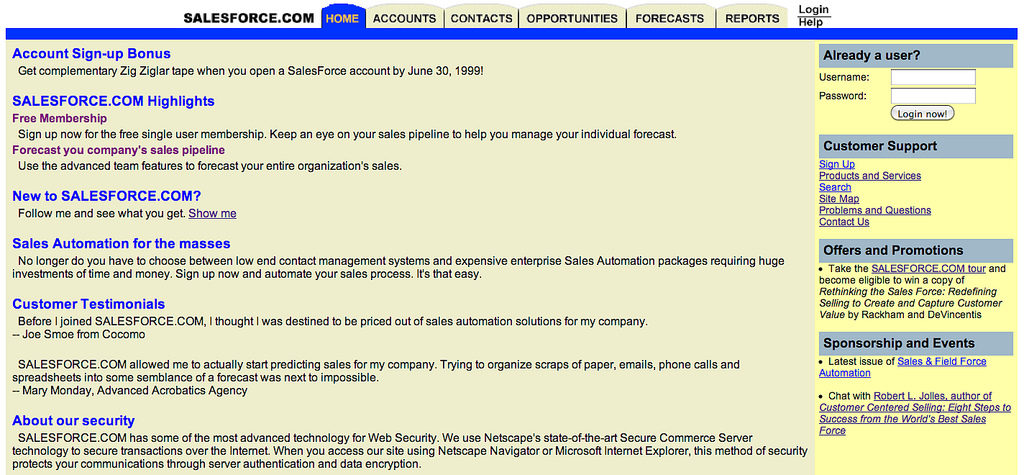Reading Time: 4 minutes
Subscribe
Get the latest Flow State content delivered to your inbox
You can unsubscribe at any time. Privacy Policy.
It’s hard to believe now, but there was a time when every desk in an office sported a white box and a bulky monitor. Wires snaked their way across the office floor, converging in what was ominously dubbed the ‘server room’—a chilly, noisy chamber filled with whirring machines and deliberately cooled air.
Regularly, like clockwork, a mustachioed man in a pinstripe suit would grace the head office, performing the sacred ritual of “updating” our CRM. During these sessions, accessing customer records became a near-impossible feat, leaving the sales function temporarily paralyzed.
Then came the day when the norm was shattered. The wires vanished, the server room expanded into the kitchen, and the mustachioed man ceased his visits. In his place, we were introduced to a new marvel called Salesforce.
The significance of Salesforce cannot be overstated. It revolutionized the way businesses operated, fundamentally altering the landscape of commerce. Picture this hypothetical dialogue between Salesforce and a potential customer:
Salesforce: “Hello! We’d like to securely store all your invaluable customer data and grant you seamless access through our platform.”
Customer: “Where exactly will you store it?”
Salesforce: “Oh, just on the cloud.”
Customer: “What’s the cloud?”
Salesforce: “It’s essentially the internet, but rest assured, it’s safe. Trust us we’ve been doing this for 12 weeks”
Trust in Salesforce required a monumental leap of faith from businesses. Without this leap, the Software as a Service (SaaS) model, as we know it today, might not have come to fruition. Salesforce paved the way for companies to entrust their most sensitive data to cloud-based platforms, setting a precedent for the future of business technology.
Salesforce often faces criticism, especially from sales teams and those tasked with managing it within a company. It’s often labeled as nothing more than an expensive spreadsheet, but such remarks miss the mark. Despite attempts to jazz up its appeal, CRMs are akin to infrastructure tools—essential but rarely thrilling. We only truly appreciate central heating when it malfunctions, and we’re left shivering in a cold shower.
As of the time of writing, Salesforce boasts a staggering market capitalization of $278 billion (USD), solidifying its status as one of the most stable, predictable, and attractive investments in the tech sector. Achieving such heights isn’t a feat for the mediocre.
So, what’s the secret to Salesforce’s perpetual triumphs?
Reimagining Business Dynamics with Cloud-Based CRM
When Salesforce burst onto the scene, it wasn’t just a new player in the CRM game—it was a disruptor. By introducing a cloud-based solution, Salesforce dismantled the traditional approach to software deployment. Gone were the days of being tethered to on-premise systems; now, businesses could break free from costly infrastructure and endless maintenance cycles. The liberation was palpable, as companies embraced powerful CRM tools without the burden of cumbersome setups.

Scaling Up with Ease and Precision
At the core of Salesforce’s appeal lies its unparalleled scalability and adaptability. Unlike its predecessors, Salesforce offered a dynamic framework that effortlessly evolved alongside businesses. Say goodbye to clunky upgrades and costly customizations; with Salesforce, organizations could tailor their CRM systems on the fly, whether expanding operations or pivoting strategies in response to market shifts. Flexibility became the new norm, empowering businesses to shape their CRM solutions to fit their unique needs.
Nurturing Innovation in a Vibrant Ecosystem
Salesforce didn’t just revolutionize CRM; it cultivated a thriving ecosystem of innovation. With the introduction of the Salesforce AppExchange, developers found a fertile ground to create and distribute a plethora of applications seamlessly integrated with the platform. This marketplace not only expanded Salesforce’s functionality but also sparked a culture of collaboration and creativity, driving continuous innovation across industries.
Human-Centric Technology at Its Core
Beyond its technological prowess, Salesforce stands out for its unwavering focus on people. From its subscription-based model to its customer-centric approach, the company places humans at the heart of its operations. This commitment to building genuine partnerships fosters trust and collaboration, underpinned by a shared goal of mutual success and growth.
Embracing the Digital Frontier with Innovation
As the digital landscape evolves, Salesforce remains at the forefront of innovation. By embracing emerging technologies like AI and mobile computing, the company continually expands its offerings to meet the evolving needs of businesses in a digital-first world. It’s not just about keeping up with the latest trends; it’s about shaping the future of work and commerce, anticipating needs, and delivering solutions that empower businesses to thrive.

Navigating Uncertainty with Resilience and Agility
In times of unprecedented challenges, Salesforce demonstrates remarkable resilience and agility. Initiatives like Salesforce Anywhere and Work.com provide essential resources and support for businesses navigating remote work, crisis response, and employee well-being. By empowering organizations to adapt and thrive in the face of adversity, Salesforce solidifies its position as a trusted partner in times of change.
Salesforce’s impact transcends technology; it embodies a profound shift in how businesses leverage innovation for growth and success. As we look ahead, one thing is clear: the influence of Salesforce on the world of SaaS is not just revolutionary but enduring, shaping the future of business in ways yet to be imagined.
Find out about our SaaS sales team training programmes and how we can help you to unlock the full revenue potential of your sales team.




One thought on “How Salesforce Changed Saas”
Comments are closed.